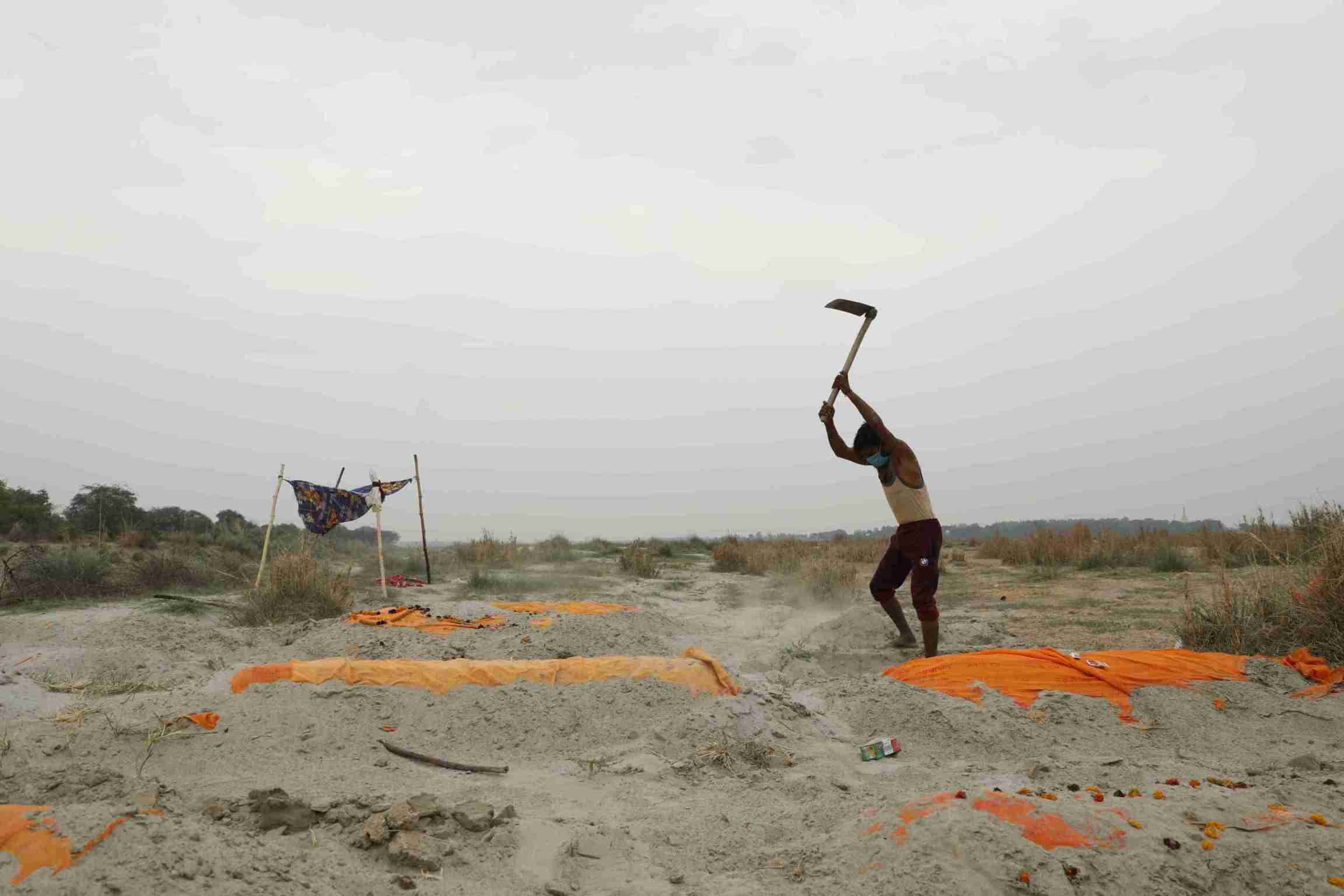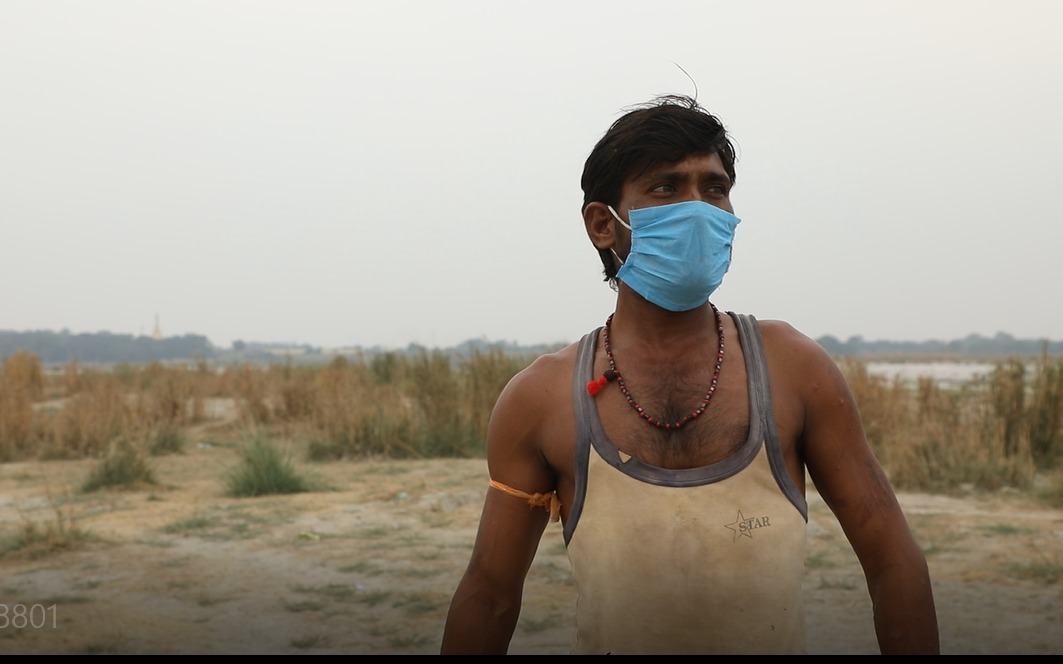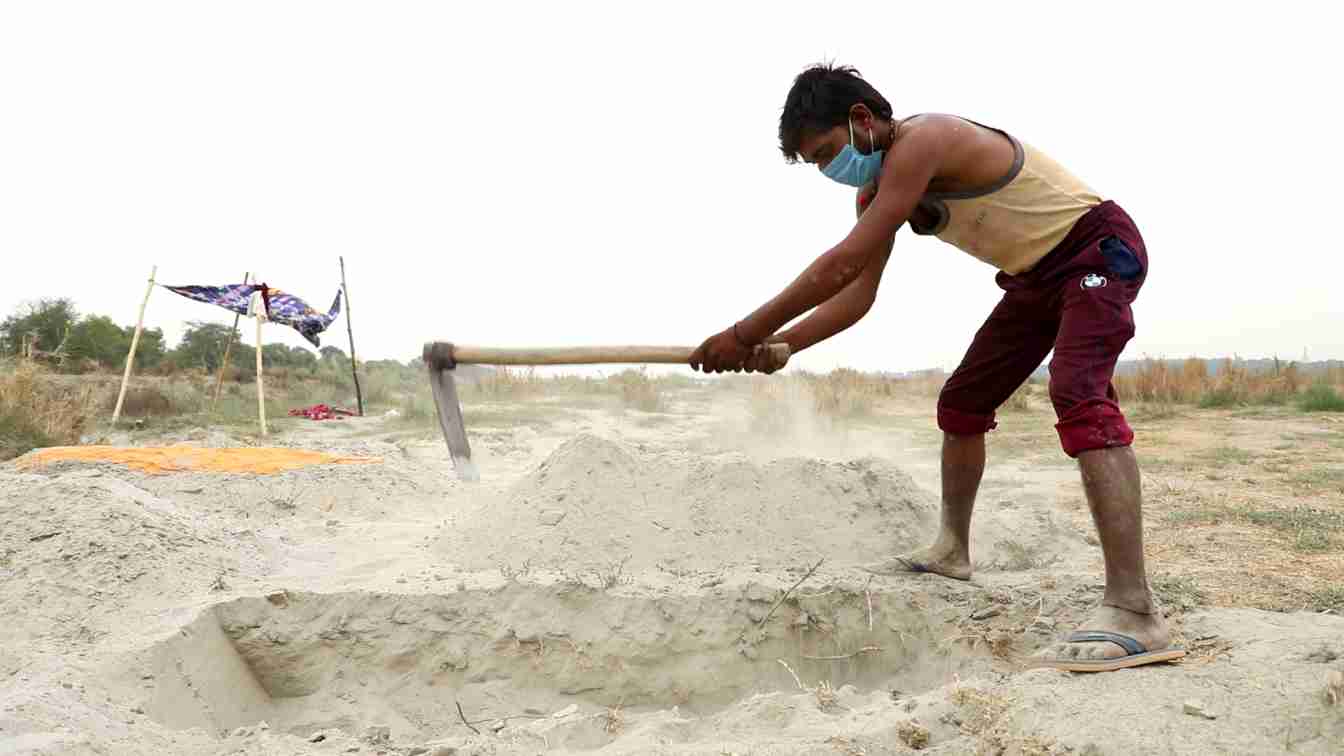No peace yet for the dead in Unnao
Despite a ban by the Uttar Pradesh government on indiscriminate burials being carried out on the banks of the Ganges, the practice continues in Unnao district. The state government has announced a support of Rs 5,000 per cremation for the poor families.

Unnao, Uttar Pradesh
Wrapped in an orange shroud, a dead body waits, as Kanhai digs a grave for it in the powdery soil, by the side of the Ganges river, at Balai ghat in Unnao.
The spade moves up and down rhythmically and 36-year-old Kanhai stops every now and then to rest his arms and wipe his palms on his maroon trousers. His baniyan (vest) is wet with sweat and the flying dust sticks to it.
Since the second wave of COVID19 has made its merciless way into rural India, deaths have gone up exponentially, though it is hard to attribute those deaths to the coronavirus as testing remains low in villages. Gravediggers such as Kanhai have been kept busy, day and night, as bodies arrive faster than they can dig the graves.

A week back, on May 13, Gaon Connection reported how there were innumerable freshly dug graves by the Ganga on the Baksar ghat of Unnao, about 95 kilometres from the state capital Lucknow. Because of the spurt of burials and the haste in which they were being carried out, many of the graves were left shallow and wild animals were digging up the remains. There were also reports of people disposing of the cadavers in the river.
As media spotlight fell on Unnao’s Ganga ghats, on May 15, the district magistrate of Unnao, Ravindra Kumar banned the burial of bodies on the ghats. Police have been stationed at the ghats to prevent any burials taking place. Gaon Connection had reported how moneyless families were being forced to bury their dead kin and not cremate because cremation cost Rs 15,000-20,000 and burying Rs 500-700.
Also Read: Married at 11, widowed at 26. Funeral rites organiser at the Ganga ghat for 20 years
Meanwhile, on May 14, Manoj Kumar Singh, additional chief secretary of the state government announced a support of Rs 5,000 per poor family to take care of the last rites of their dead family members.
But what is really happening on the ground?

The Ganga ghats of Unnao
The Ganges meanders for about 84 kilometres through the Unnao district that has 21 ghats along its flow. These ghats start from the Nanamau ghat in Bangarmau tehsil to Baksar ghat in Bighapur tehsil. Gaon Connection met Kanhai at the Balai ghat on May 17 where he was busy digging graves and burying the dead.
Kanhai said he was not aware of any assistance (Rs 5,000 per cremation) by the government. “Those who bring the wood along with them cremate their dead. The others who are too poor to afford wood continue to bury their dead relatives,” he said, adding there was no wood being handed out by the authorities at the ghat he was working in.
Kanhai arrives at the ghat at 9 am every day and was still digging graves at 1 pm when the Gaon Connection reporter met him. “In the recent past, I have witnessed 17 dead bodies coming to the ghat, of which nearly 10 were buried,” Kanhai said.
Also Read: “I have been digging graves morning to night… the work never ends”
“Sometimes the entire day goes by digging graves,” Kanhai said. While he did not know the exact cause of the deaths, he did say that from some of the relatives who had gathered he learnt most had died of fever or a cough.

Ban on burying
The district administration claims it has made suitable arrangements at the Ganga ghats. “Arrangement for wood for cremation has been made at every ghat. In case someone wants to bury their dead, they can do so in an area that has been demarcated for them,” Satyapriya Shukla, sub divisional magistrate of Unnao, told Gaon Connection. He pointed out that people belonging to the Kabir sect bury their dead. He also emphasised that if someone was found flouting the rules, they would be stopped.
“At every ghat in Unnao, there are officials positioned who have the contact details of the respective block and panchayat ADOs (Assistant Development Officer),” Rajendra Prasad, district panchayat raj officer, told Gaon Connection.
Those who needed wood could get in touch with the official present at the ghat who in turn would verify their details and economic status from the respective panchayat and then issue the wood for the cremation, Prasad explained. “The money for the wood will be deducted out of the sanctioned Rs 5,000 and the balance would be deposited into the account of the next-of-kin of the dead,” he added.
While police presence could perhaps deter those from burying their dead in the designated 21 ghats in the district, there are many places where the river banks are not policed. Villages dotting the riverside, continue to perform the last rites in these places that have escaped the police net.
Rahul Yadav, from Balai village in Unnao, said it was unlikely the burials would stop. “People have no money. What can they do in such a situation? They have no other option,” he told Gaon Connection.
Written and edited by Pankaja Srinivasan.

